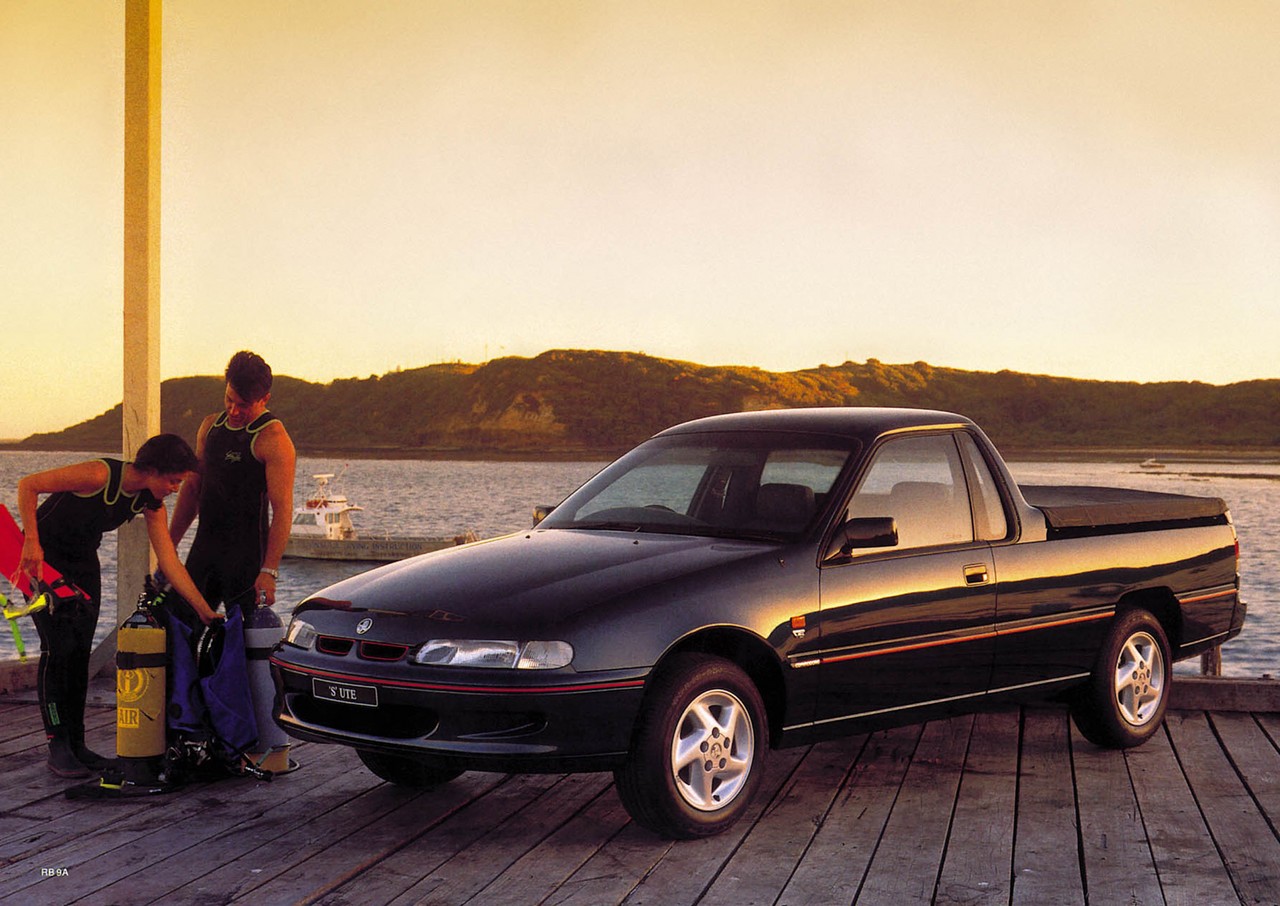
- Fuel-efficient 3.8-litre L27 V6 engine
- Responsive 5.0-litre V8 engine
- Spacious interior
- Comfortable ride and competent dynamics
- V6 engine coarse above 3000 rpm
- Clunky downshifts for automatic transmission
- Sensitive throttle and spongy brake pedal
- Poor standard of interior fit
Review: Holden VR.I Ute (1993-94)
Overview
Released in July 1993, the Holden VR Series I (VR.I) Ute was a rear-wheel drive, single cab utility. Manufactured in Elizabeth, South Australia, the VP Ute was available with 3.8-litre V6 and 5.0-litre V8 engines. As per the table below, the range consisted of Ute and Ute S models.
V6 and V8 Engines
Of the engines,
- The 3.8-litre L27 pushrod V6 petrol engine had a cast iron block and cylinder head, multi-port fuel injection, two valves per cylinder, a single balance shaft and a compression ratio of 9.0:1. For the VR Ute, this engine had new pistons, a higher compression ratio (previously 8.5:1), more rigid connecting rods, reduced bearing clearances and roller valve rocker pivots – these changes were introduced for smoother running and improved fuel economy; and,
- Carried over from the VP Ute, the 5.0-litre LB9 pushrod V8 engine had a cast iron block, two valves per cylinder, multi-point fuel injection and a compression ratio of 8.4:1.
Transmissions: 4L60E and M39 T5
Both the V6 and V8 engines were available with electronically-controlled four-speed 4L60E automatic and five-speed Borg Warner M39 T5 manual transmissions.
Dimensions and VP comparison
Compared to the VP Ute , the VR Ute was 7 mm shorter (at 4896 mm), 14 mm wider (1794 mm) and 2 mm lower (1510 mm), though the wheelbase was unchanged at 2821 mm long; payload was 710 kg. Furthermore, the load floor was 2145 mm long by 1520 mm wide, with 1172 mm between the wheel arches.
Visually, the VR Ute could be identified by its revised front mask and round rear wheel arches. Inside, there was a new dashboard and a smaller steering wheel.
Suspension
Based on an extended wheelbase VR Commodore platform, the VR Ute had MacPherson strut front suspension and a live rear axle with five links and coil springs. Relative to the VP, the VR Ute had a wider front track and retuned suspension.
| Engine | Years | Trans. | Peak power | Peak torque | |
|---|---|---|---|---|---|
| Ute | 3.8-litre L36 petrol V6 | 1993-94 | 5sp man., 4sp auto |
130 kW at 4800 rpm | 295 Nm at 3200 rpm |
| Ute S | 3.8-litre L36 petrol V6 | 1993-94 | 5sp man., 4sp auto |
130 kW at 4800 rpm | 295 Nm at 3200 rpm |
| 5.0-litre petrol V8 | 1993-94 | 5sp man., 4sp auto |
165 kW at 4400 rpm | 385 Nm at 3600 rpm |
Safety equipment
The VR Ute was not fitted with safety equipment such as a driver’s airbag or ABS as standard.
Brakes
The VR Ute had 289 mm by 23 mm vented front brake discs and 279 mm by 10.5 mm solid rear discs.
Features
Standard features for the Ute included 15-inch steel wheels, a two speaker sound system with a radio and cassette player, power mirrors, vinyl seat trim, a height adjustable driver’s seat, rubber cabin flooring and an immobiliser.
The Ute S was further equipped with 15-inch alloy wheels and sports trim.
Review: Holden VR.II Ute (1994-95)
Overview
Released in September 1994, the VR Series II (VR.II) was a minor update for the Ute. As part of the update, the V6 engines were fitted with a new exhaust manifold (for quieter running); the V8 engines were also fitted with a different starter motor. Other changes included a convex passenger side door mirror and a ‘low fuel’ warning light and chime.
| Engine | Years | Trans. | Peak power | Peak torque | |
|---|---|---|---|---|---|
| Ute | 3.8-litre L36 petrol V6 | 1994-95 | 5sp man., 4sp auto |
130 kW at 4800 rpm | 295 Nm at 3200 rpm |
| Ute S | 3.8-litre L36 petrol V6 | 1994-95 | 5sp man., 4sp auto |
130 kW at 4800 rpm | 295 Nm at 3200 rpm |
| 5.0-litre petrol V8 | 1994-95 | 5sp man., 4sp auto |
165 kW at 4400 rpm | 385 Nm at 3600 rpm |
Features
Compared to their VR.I predecessors, standard features were extended to include a speed alert which sounded a tone when a preset speed was exceeded.
Related links



